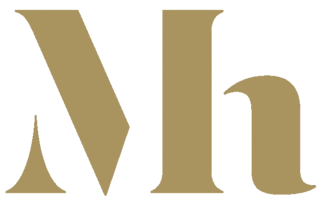
The Mauritshuis is an art museum in The Hague, Netherlands. The museum houses the Royal Cabinet of Paintings which consists of 854 objects, mostly Dutch Golden Age paintings. The collection contains works by Johannes Vermeer, Rembrandt van Rijn, Jan Steen, Paulus Potter, Frans Hals, Jacob van Ruisdael, Hans Holbein the Younger, and others. Originally, the 17th-century building was the residence of count John Maurice of Nassau. It is now the property of the government of the Netherlands and is listed in the top 100 Dutch heritage sites.
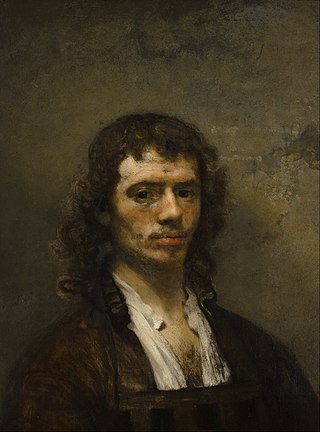
Carel Pietersz. Fabritius was a Dutch painter. He was a pupil of Rembrandt and worked in his studio in Amsterdam. Fabritius, who was a member of the Delft School, developed his own artistic style and experimented with perspective and lighting. Among his works are A View of Delft, The Goldfinch (1654), and The Sentry (1654).

Karel van Mander (I) or Carel van Mander I (May 1548 – 2 September 1606) was a Flemish painter, poet, art historian and art theoretician, who established himself in the Dutch Republic in the latter part of his life. He is mainly remembered as a biographer of Early Netherlandish painters and Northern Renaissance artists in his Schilder-boeck. As an artist and art theoretician he played a significant role in the spread and development of Northern Mannerism in the Dutch Republic.

Jozef Israëls was a Dutch painter. He was a leading member of the group of landscape painters referred to as the Hague School and was, during his lifetime, "the most respected Dutch artist of the second half of the nineteenth century."

Anthonij "Anton" Rudolf Mauve was a Dutch realist painter who was a leading member of the Hague School. He signed his paintings 'A. Mauve' or with a monogrammed 'A.M.'. A master colorist, he was a very significant early influence on his cousin-in-law Vincent van Gogh.

The Hague School is a group of artists who lived and worked in The Hague between 1860 and 1890. Their work was heavily influenced by the realist painters of the French Barbizon school. The painters of the Hague school generally made use of relatively somber colors, which is why the Hague School is sometimes called the Gray School.

Jan Lievens was a Dutch Golden Age painter who was associated with his close contemporary Rembrandt, a year older, in the early parts of their careers. They shared a birthplace in Leiden, training with Pieter Lastman in Amsterdam, where they shared a studio for about five years until 1631. Like Rembrandt he painted both portraits and history paintings, but unlike him Lievens' career took him away from Amsterdam to London, Antwerp, The Hague and Berlin.

Albert Carel Willink was a Dutch painter who called his style of Magic realism "imaginary realism".
Carel Balth was a Dutch artist and curator.

Carel van Savoyen or Carel van Savoy (1620/21–1665) was a Flemish painter, draughtsman and printmaker who was active in Antwerp and Amsterdam. He is mainly known for his history paintings and portraits but he also painted allegories and genre scenes.
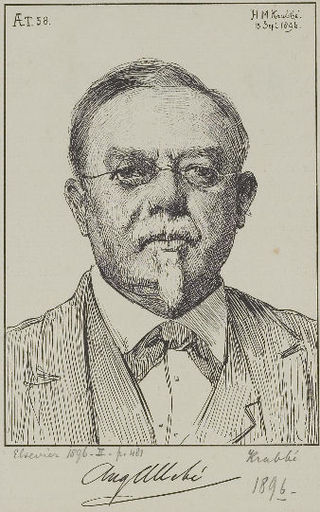
August Allebé was an artist and teacher from the Northern Netherlands. His early paintings were in a romantic style, but in his later work he was an exponent of realism and impressionism. He was a major initiator and promoter of Amsterdam Impressionism, the artist's association St. Lucas, and the movement of the Amsterdamse Joffers. Amsterdam Impressionism – sometimes referred to by art historians as the School of Allebé – was the counterflow to the very strong Hague School in the movement of Dutch Impressionism. As a professor at the Royal Academy of Amsterdam he fostered a cosmopolitan attitude toward art and the promotion and motivation of his students, and provided a significant stimulus to developments in modern art.

Carla Maria Fong Leng Tsang is a Chinese-Dutch fashion designer. Fong Leng started a fashion boutique in 1969 in the Drugstore at the Nieuwendijk in Amsterdam. In 1971 she moved to larger premises at the P.C. Hooftstraat and called it Studio Fong Leng. She is mostly known for her extravagant cloak dresses. Fong Leng’s most notable client was Mathilde Willink, the divorced wife of the Dutch magic realist painter Carel Willink.

Jan Hillebrand Wijsmuller was a Dutch painter. He belongs to The 2. Golden Age of Dutch Painting.

Willink van Collenprijs is a former Dutch art award, which was awarded for the first time in 1880 by the Sociëteit Arti et Amicitiae. It was intended as an encouragement award for young artists, and was considered as a national counterpart to the Paris Salon. Its existence of more than 71 years proves the success of Amsterdam's art policy. For many of its winners, it was a valuable boost to their careers in the Dutch art world. Some of the prize winners were also recognized abroad and remain well known today.
Daniël (Daan) van Golden was a Dutch artist, who has been active as a painter, photographer, collagist, installation artist, wall painter and graphic artist. He is known for his meticulous paintings of motives and details of everyday life and every day images.
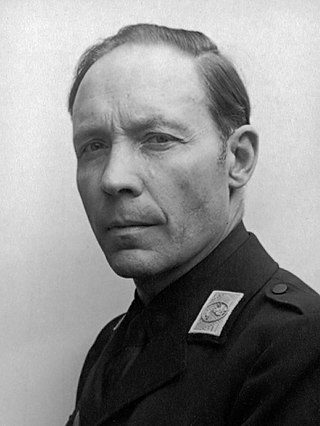
Ed Gerdes or Eduard Gerdes (1887–1945) was a Dutch painter, art teacher, member of honorary art selection committees and during the last years of his life head of the Dutch Kultuurkamer.

Annie Nicolette Zadoks-Josephus Jitta was a Dutch numismatist and archaeologist.
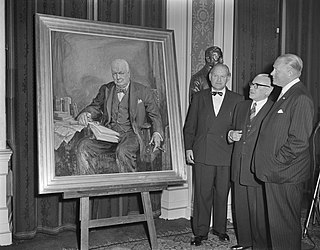
Marten Ykes "Max" Nauta was a Dutch painter, especially noted for his portraits, and stained glass artist.

Late Visitors to Pompeii is a 1931 painting by Carel Willink. It depicts four modern men at the forum of Pompeii with Mount Vesuvius in the background. The painting belongs to the Museum Boijmans Van Beuningen since 1933. It has been interpreted in correlation with the cultural philosophy of Oswald Spengler, who is one of the men in the painting, and themes of civilisational crisis in the fiction of Ferdinand Bordewijk.
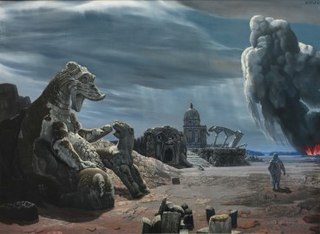
To the Future is a painting made by the Dutchman Carel Willink in 1965. It shows two sculptures from the Garden of Bomarzo and a man in an asbestos suit who walks toward a large explosion. It belongs to a group of late Willink paintings that portray apocalyptic confrontations between modern technology and the ancient world. To the Future is in the collection of Museum MORE in the Netherlands.



















